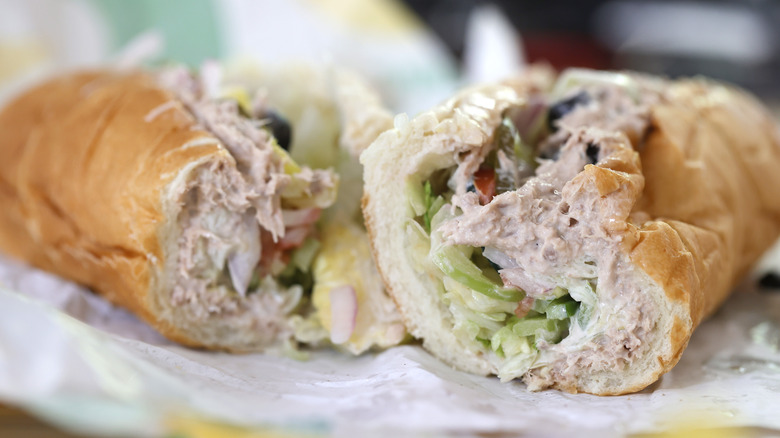Scientists Can't Agree On What's Really In Subway's Tuna Sandwiches
July marks month number seven of the great Subway tuna sandwich debate. In January, two California women sued Subway, alleging that they tested several of the chain's tuna sandwiches in a lab and found that the ingredients were not tuna nor fish, but a "mixture of various concoctions" mixed together to "imitate the appearance of tuna" (via the Washington Post). Subway fought back, saying that it uses only wild-caught tuna in its subs. The plaintiffs then slightly amended the lawsuit, The New York Times reported, questioning only whether or not the tuna is "100% sustainably caught skipjack and yellowfin."
That was only phase one of the controversy. Next, news outlet Inside Edition conducted its own investigation of the sandwiches. Reporters sent samples from three tuna subs to Applied Food Technologies for DNA testing, according to a press release sent to Mashed, and received confirmation that they all contained tuna. The story doesn't end there. Last month, The New York Times published a story detailing its own investigation, which hired an anonymous testing center to test another round of sandwiches. The results? "No amplifiable tuna DNA was present in the sample."
What do these conflicting results tell us about Subway's tuna?
A spokesman from the anonymous lab used by The New York Times said that its findings offer two possible conclusions. "One, it's so heavily processed that whatever we could pull out, we couldn't make an identification," he said, meaning that Subway's tuna goes through so much processing that it becomes genetically unrecognizable. Two, "there's just nothing there that's tuna."
Following the Times' story, Inside Edition conducted a second test of Subway's tuna and found, again, that it does contain tuna. An expert from Applied Food Technologies, the lab used by Inside Edition, "suspects the lab that The New York Times used may not have the proper technology to extract DNA from tuna that has already been cooked and processed." Peter Horn, director of the Ending Illegal Fishing Project, confirmed that it can be tricky to test fish, telling the New York Times that "the further you get the fish from the bone, the harder it is to recognize what that fish is." Since Subway claims to use flaked canned tuna mixed with mayonnaise, it may be difficult for certain types of DNA tests to detect the fish.
All three parties — Subway, Inside Edition, and The New York Times — stand by their claims, which means it is up to diners to decide whether or not they want to continue eating Subway's tuna sandwiches. Most people question why Subway would lie about its ingredients, says the Times. "I don't think a sandwich place would intentionally mislabel," a representative from Catalina Offshore Products told the paper. "If there's any fraud in this case, it happened at the cannery."

